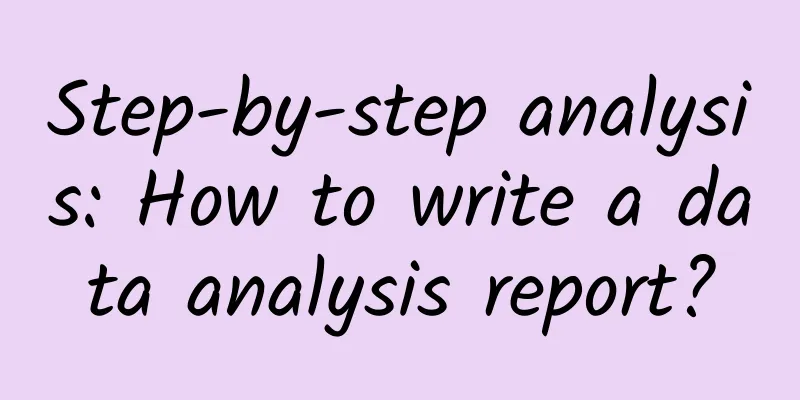Step-by-step analysis: How to write a data analysis report?

|
[51CTO.com Quick Translation] As a data analyst, sooner or later you will need to write a report based on your findings. Obviously, since many people are much more familiar with numbers than words, writing reports becomes the most headache-inducing problem. In addition to templates and tools, we should also look at the entire report writing process from a more fundamental perspective. This is the core of this article - a step-by-step analysis of how to write a data analysis report.
Learn what people don’t know yet In fact, you must be prepared that the audience of your report will not understand what you are trying to express in your report. Translating numbers into words is often difficult and involves multiple disciplines and knowledge systems. But don't worry, we will explain it step by step below. Establish the core objectives of the report First, you need to identify the core objectives of your report and tailor them to the specific circumstances of your audience. Are they simply interested in the results, or do they want to understand how to get to the final conclusion through step-by-step analysis? The specific answer will help you better position your report. Decide on the specific report presentation type The report usually begins with an introductory content (sometimes we will come back to it after the main text is completed), which can be completed in the form of a summary, overview or abstract. Summary introductions are usually aimed at decision makers with clear goals, overview introductions are more general, and abstract introductions are aimed at other data analysts. Note that the format is correct Through various templates, you will find that the actual format of the report varies greatly and each has its own advantages, that is, each is suitable for specific needs, including administrative briefings, letter reports, journal articles or white papers. There is no distinction between good and bad specific formats, everything is based on your needs. Create a draft After choosing the format, the next step is to create a draft report. Here we need to record the various sections, corresponding titles (can be modified at any time) and summarize the general content in a few sentences. This will help everyone understand the workload and complexity, and avoid wasting time on unnecessary topics. Pay attention to the deadline Be aware of the time available to write the report and do everything you can to meet the deadline. Remember, you need to have enough time for editing, proofreading, and delivery in addition to writing the report. You also need to use visualization resources to make your data clearer and easier to understand. All of this needs to be reflected in the time investment. Start writing now Don't expect that the first draft will be passed, so as a first draft, we should pay close attention to the parts related to the meaning of the data, and temporarily ignore grammar, spelling or language style. This is the experience of well-known writers, and it is also worth learning from. Take a break and change your mood Before moving on to the next step, everyone can take a break to change their mindset. If we work for a long time, we may not realize that there is room for improvement. Report Editing Approach your report from a different perspective. Remember, you are not writing your report for yourself, but for a specific audience. They should be able to read your report without having to use Google or a dictionary. So adjust your presentation based on that, and feel free to add in any sections that might make sense to your audience. Include valuable visual resources Without visual assets, there is no analysis report. However, you also need to make sure that all the tables, graphics, and other elements are relevant to the audience. Simply adding visual elements will make it feel unfocused and difficult to understand. Therefore, carefully consider the color and format matching to make those graphics more effective. Report Proofreading Now we start to check the grammar and spelling in the report. Again, you should put the report aside for a few days before checking it again to avoid being influenced by existing ideas. Final Advice: Ask Others to Read Once everything is ready, you should invite others to read the report. It is best to have a specific audience, but it can be anyone else. This way, we can adjust, improve, or add to the content based on their feedback. OK, we are done here, let's submit the report! Original title: How to Write a Data Analysis Report Original author: Janet Anthony [Translated by 51CTO. Please indicate the original translator and source as 51CTO.com when reprinting on partner sites] |
>>: my country will compete for the leading position in 5G communication coding standards
Recommend
RAKsmart: VPS flash sale from $0.99/month, cloud server flash sale from $1.99/month, Hong Kong/Japan/Korea/Germany/US data centers
RAKsmart is offering flash sales for VPS and clou...
Ministry of Industry and Information Technology: my country breaks through 5G key technologies and commercial equipment will be launched before the end of the year
According to CCTV reports, at the 2018 5G Summit ...
Ruijie Cloud Desktop solves financial development and testing problems and is praised by Yixing Rural Commercial Bank!
Technology drives the transformation of the times...
China Telecom: Continue to build a comprehensive 5G private network solution integrating "network edge cloud and service"
With the continuous advancement of "new infr...
How will the Internet of Things impact future data centers?
The Internet of Things is more than just an explo...
AlphaVPS: 128GB-2TB large hard disk VPS annual payment starts from 15 euros
AlphaVPS is a Bulgarian hosting company registere...
IT Knowledge Encyclopedia: Detailed Explanation of IPv6
As an Internet user, you have more or less heard ...
5G starts with the network taking the lead. H3C MSR 5G router promotes the implementation of 5G applications
In the era of the Internet of Everything, 5G, as ...
Gartner: The number of devices in use worldwide will reach 6.2 billion in 2021
[[391127]] Recently, Gartner pointed out that the...
VR resolution increased by 4 times, Yiche App released a new version to meet the needs of 5G mobile phone users
December 3, Yiche officially released the Yiche A...
CloudCone Flash Sale starts at $15.5/year - 1GB/55GB/3TB@1Gbps/Los Angeles Data Center
CloudCone launched a flash sale in April, offerin...
How to build a universal smart IoT gateway by reducing the data sampling rate
【51CTO.com Quick Translation】Although there are m...
With another 600,000 base stations added, do you plan to upgrade to a 5G package?
As we all know, my country's operators have b...
Gather: A method to optimize the number of control flow tables in SDN networks with in-band control
1. Introduction In-band SDN networks have attract...
Three major dilemmas of big data
【51CTO.com Quick Translation】 Big data, as a set ...









